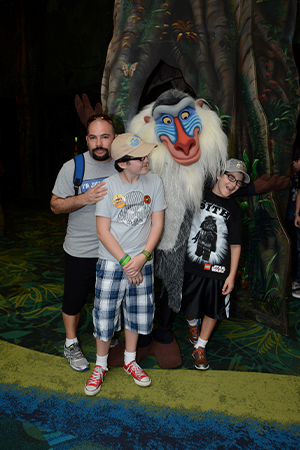“I didn’t want epilepsy to stop me from ever doing what I wanted to do. I didn’t let it ruin me.”
Diagnosed with epilepsy at 5 years old, Chris, now an adult and father of two sons, has lived most of his life enduring multiple seizures at a time every couple of months.
"I never knew exactly when it would happen," says Chris. "But I started to see a pattern of going 3-4 months without and then all of the sudden, I'd have a few days of multiple seizures."
Chris began his care for epilepsy at Children's Hospital of Philadelphia (CHOP). He eventually transitioned to the adult epilepsy program at the Comprehensive Epilepsy Center at Penn Medicine at 18.

"The transition from CHOP to Penn was seamless," says Chris. "Dr. [Brian] Litt, my Penn neurologist, had my complete medical history and it was like he had been a part of my care team the entire time."
Throughout his care at CHOP and at Penn, Chris recalls being on several medications to help manage his seizures. He says that the medication would work for some time, then stop working. Finally, in 2014 Chris was fed up with his routine seizures and medications. He wanted to explore another treatment option: surgery.
In order to determine whether or not he was a candidate for surgery, Chris had to go through multiple testing and procedures, beginning with an MRI.
Chris's MRI came back normal, allowing him to move on to the next step: a weeklong study in Penn's 8-bed Epilepsy Monitoring Unit (EMU). In the EMU, Chris was taken off of all of his seizure medication and monitored by an electroencephalogram (EEG) and video EEG that was used to record Chris's movements before, after and during a seizure. This recording was done through the use of electrodes, pasted onto Chris's scalp, that measured the changes in electric activity in his brain. The goal of this was to determine the type and severity of Chris's seizures.
Chris's next test was the Wada Test, which determines what side of your brain has your language and memory functions. During the test, one side of the brain is put to sleep under anesthesia. The results helped Chris's team understand what memory and language function would be lost if they were to remove a portion of either side of the brain. While Chris was nervous to have his brain "put to sleep one side at a time," he was happy to hear the results: no memory or language function would be lost by removing the part of the brain responsible for his seizures. He was a good candidate for surgery!
In the first surgery, Dr. Tim Lucas, a neurosurgeon at Penn Medicine, placed electrodes inside of his brain to map the exact location of the seizures. Chris then spent 14 days being monitored in the hospital without medication and experiencing multiple seizures a day. After two weeks, Dr. Lucas was ready to perform the second part of the surgery on Chris to remove the pinpointed portions of his brain that were causing seizures.
"I was pretty intimidated when I heard that 2 inches of my brain would be removed," says Chris. "But it didn't stop me from wanting to go through with the second part of the surgery."
Following surgery, Chris spent three days in recovery and was able to return to work in six weeks.
"One of the things that made me really nervous about the surgery was that I wouldn't be able go on a planned vacation with my family," says Chris. "But, two months after my surgery, I enjoyed a fun vacation in Disney with my two boys. And I was seizure free."
It's been one year since his surgery, and Chris says he's had no set-backs and says he is happier and healthier than ever.
"I didn't want epilepsy to stop me from ever doing what I wanted to do," says Chris. "I've always been athletic and a hard worker. I didn't let it ruin me."
And he doesn't want it to ruin other people's lives either. Chris adds that he enjoys giving back and helping others with epilepsy by being a camp counselor at Camp Achieve for the Epilepsy Foundation of Eastern. He's been a counselor for 10 years and looks forward to every year.